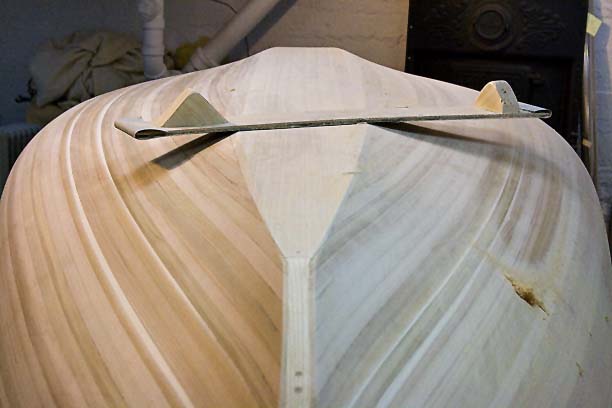Staple Holes Filled
Some people really hate this part, but I love sanding and smoothing. It’s slow work, but the wood goes through a pleasing transformation, both visual and tactile.
Before sanding and fairing, the staple holes, sloppy joints, and other imperfections are filled with a mixture of glue and sawdust. The first trick to filling the staple holes, and making them less prominent, is to make them smaller. You do this by soaking the wood well with a wet sponge. This causes the wood to swell and the holes to close up. In some cases, almost completely. Since the outside of the hulls will probably be painted, this is not so important now, but getting the technique right here will help later on the inside.
Raw end grain, which is what you get when you make a staple hole, turns very dark when it soaks up epoxy, which makes the holes much more pronounced. I don’t mind seeing them, but would prefer they not be distracting. Sealing them with glue allows them to darken slightly, but only to a point, and the sawdust paste helps plug and fill the gaps, making a sandable surface when it dries.
I made a fairing board with some scrap luan, gluing a rubber inner tube to the face for a bit of cushion. So far it’s working really well. I’m using 120 grit adhesive backed sandpaper, which seems a decent combination of fast action and smooth finish.
Granted, there is definitely finer sandpaper available, but once again I’m struck by the difference between sandpaper and cabinet scrapers. You really need the fairing board here to get long smooth curves and a “fair” surface, but the scrapers really bring out the natural color of the wood. In the picture above you can see the difference. The white matte finish is the surface left by the sandpaper. The darker patch in the middle, revealing the wood grain and color, is what you get with a scraper. It’s actually shiny.
It takes a full day to fair and smooth a side. In this picture, the left side has been faired and scraped, the right side just faired:

And here’s a detail of the staple holes filled, and the raw cedar wood after cabinet scrapers – no finish applied yet – with it’s rich variety of hues, from cream to yellow, rose to pale green:

melonseed skiff, mellonseed skiff, melon seed, mellon seed




Amanda
They are coming along very well!! I can’t wait to see the finished product! Not to mention sailing one soon!
Thursday, April 9, 2009 – 12:09 PM